Touring the valleys of Baztan-Bidasoa: Navarre overlooking the sea
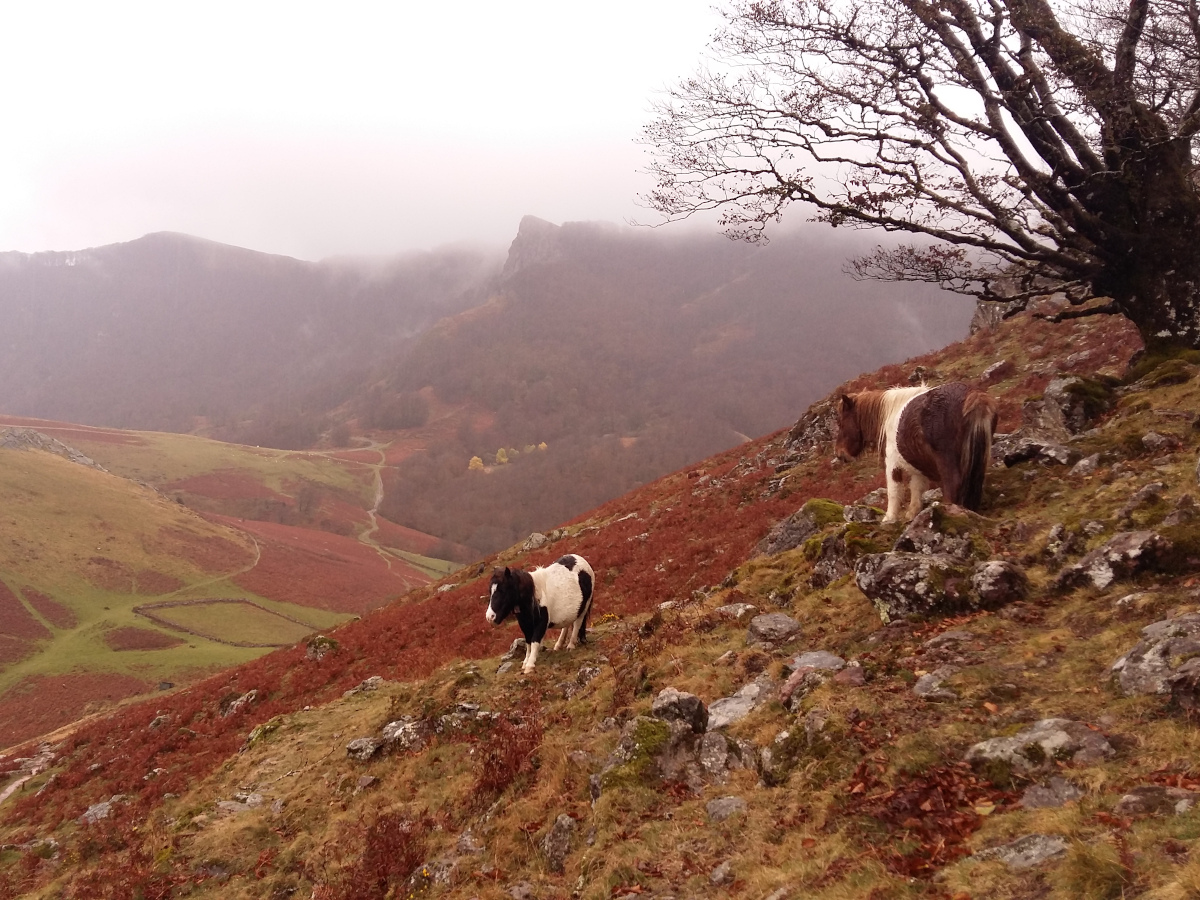
Atlantic Navarre, the humid, evergreen valleys and lush forests. A land of noblemen, of shepherds, of Indians who came from overseas; a frontier land, a kingdom of smugglers. When the high peaks soften and the rock gives way to a landscape of meadows and forests dotted with farmhouses and small villages.
The river Bidasoa flows towards the Bay of Biscay, in an apparently calm course, which could be the perfect metaphor for these valleys. To the east, the Baztan, to the west, a corridor that opens up to the north in the Regata del Bidasoa. Valleys that invite peace and quiet, idyllic green landscapes and colourful villages.. Dotted with small villages, most of which have no more than 200 inhabitants. Elizondo, Lesaka and Bera are the villages of reference, with less than 4,000 inhabitants, and a multitude of farmhouses amidst meadows where the latxa sheep graze. Mikel Albisu, geographer and historian, who decided that his life was in these mountains, welcomes us at the tourist office of the Bertiz Park as a guide and has been running the Beintza Hostel, Orbela, since 1990. "The Navarre that looks at the sea, the humid one".he tells us in front of a model of the whole region. Mikel describes a region that knows no frontiers, where the boundaries are defined by the river - the Baztan, as far as Oronoz-Mugaire, and Bidasoa, as it will be called from there onwards.- which rises at the peak of Astaté, near Erratzu, and flows into the Bay of Biscay via the Bay of Txingudi, between Hendaye and Ondarribia. The Baztan-Bidasoa region is formed by Baztan, Bertiz, the border valleys of Xareta (Zugarramurdi and Urdazubi/Urdax) and the Bidasoa regatta (Malerreka, Bidasoa and Cinco Villas). "The mountains act as a barrier to the humid sea air", massifs crowned by peaks such as Larhun (900m), Autza (1306m), Mendaur (1131m) or Aiako Harria (832m) form a perfect funnel that justifies the eternal green and rainfall of 2000 litres per year.. A mild climate, very changeable, from tropical heat in summer to mild snowfall in winter. Meadows, bracken, beech and chestnut forests. Man and ecosystem come together in a humanised, moulded landscape, in which traditions and uses have found shelter. Beeches, the remains of charcoal kilns, the "kisulabe" - kilns for making lime -, the farmhouse, the house as a farm and a means of subsistence in a hostile environment, its organisation, shepherding, smuggling, carnivals, gastronomy, everything is proof of this. The traveller will be immersed in customs, local history and legends -or all intermingled-, nature, seasoned by products and gastronomy that are born from this chimera.
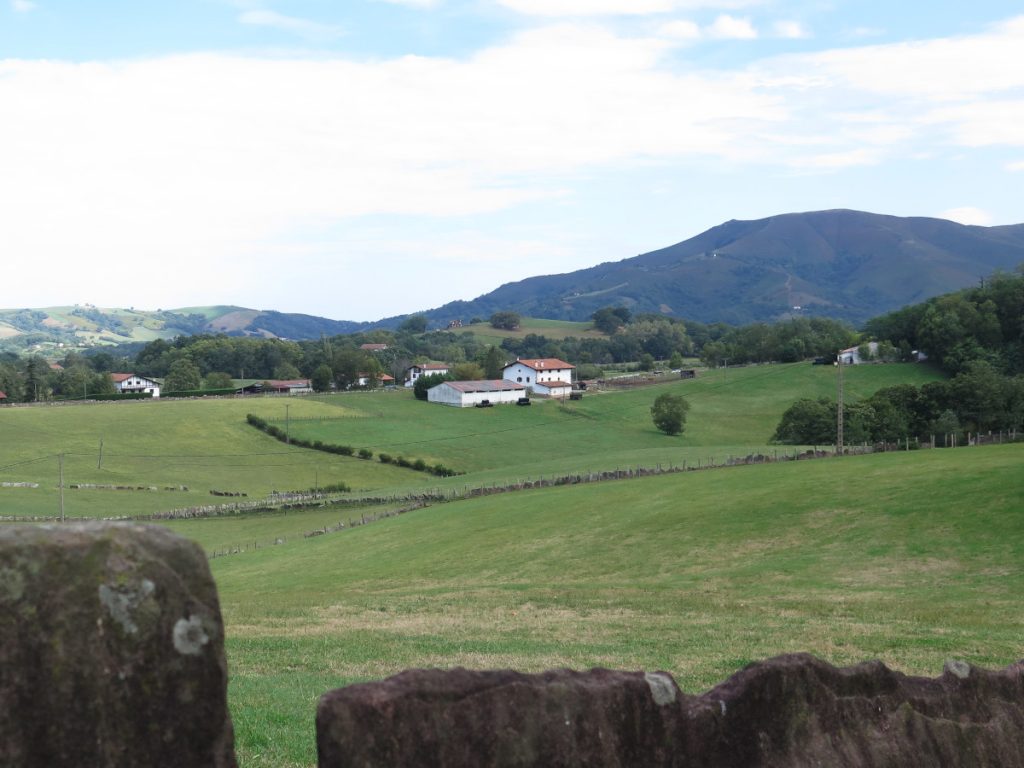
Eternal greenery and lush forests
It is enough to look up in the Baztan or Ziga lookout point to drink from the essence of these valleys, their landscape -then we will have to dive into the depths of their traditions and legends-. Nature surrounding farmhouses and livestock farms, which appear as brushstrokes over slopes and hillsides, crops and meadows, beech, oak and fern forests, with the Auza as a watchtower in the background. This may be an aperitif, but there is no doubt that to get wet in these waters you have to explore the lush forests, look down into the valleys from a hill or peak or walk the countless trails in the area, once used by smugglers who carried packages from village to village, or by pilgrims on their way to Santiago de Compostela, and nowadays frequented by hikers and cycle tourists who find here an unbeatable playground.
In the Señorío de Bertiz We walk through a forest of mainly beech and oak trees. We will find traces of old exploitations such as charcoal and timber exploitation. Intact in the most inaccessible places. With a surface area of 2,050 hectares, there is a botanical garden on one side and the Señorío nature park on the other, both of which are pure nature. The Historic-Artistic Garden of Bertiz more than 100 years old is a 4 hectare treasure, with more than 120 species, many of them brought by Pedro de Ciga on his many travels around the world, who donated the estate to Navarre after his death. The trails through the forest of Bertiz parts of the main access to the Park, the interpretation centre. An attractive route in the Baztan valley is the one that leads to the Xorroxin waterfallhidden in a leafy forest of beech and chestnut trees. From the Gorostapolo neighbourhood in Erratzu you can reach the Xorroxin waterfalls, the source of the river Baztan, which will change its name to Bidasoa on its way. If you need more immersion, the Route of the blue pottoka "Pottokaren bidea". covers 35 km of the Xareta cross-border region: Urdazubi/Urdax, Zugarramurdi, Sara and Ainhoa. The trail runs through meadows, woods and farmhouses, connecting the squares of the four villages and their three caves - Zugarramurdi, Urdax and Sara. The Baztan-Bidasoa region is also criss-crossed by various long-distance footpaths: the GR 11-Pyrenean Path (trans-Pyrenean footpath through Spain) and GR 10 (trans-Pyrenean footpath through France) together with the GR12 (Euskal Herria trail). In 2016 the FEDME completed this network with links such as the E. GR 11 - GR 12 or the GRT 5, Kulunka Bidea, which extended the alternatives between the GR and cross-border trails. With this configuration, the Bidasoa Trekking runs 137.80 km through the villages of Baztan-Bidasoa. The Baztanes Way runs southwards from Dantxarinea in Urdazubi/Urdax to Belate, to join the French Way and reach Pamplona.
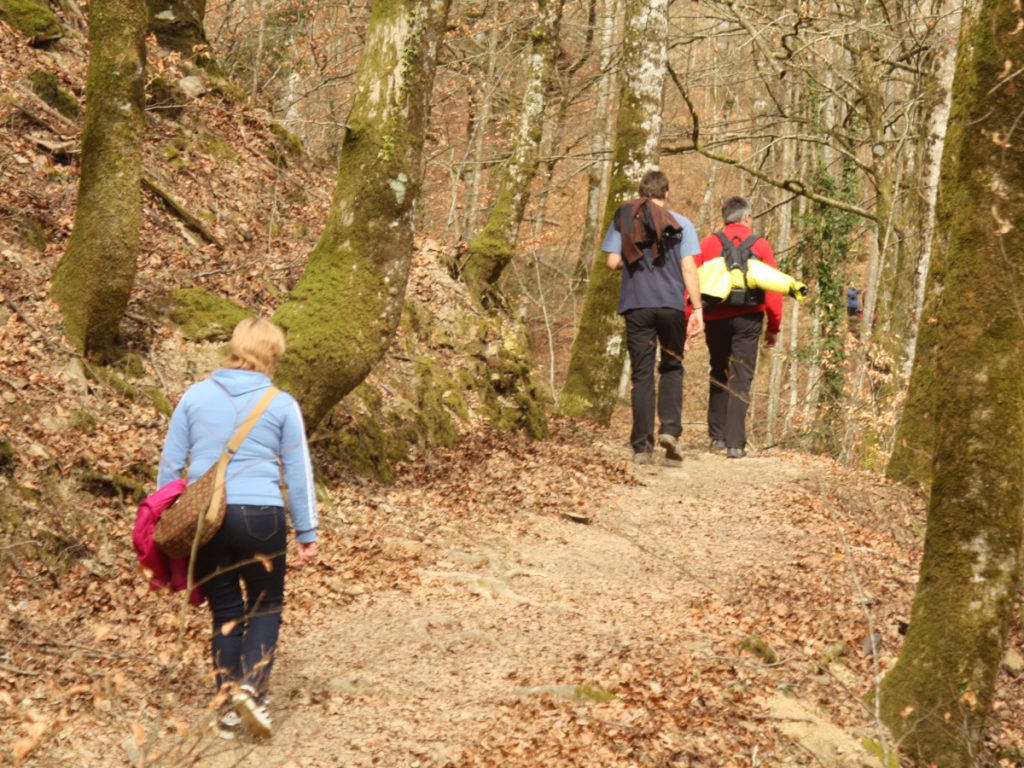
Land of nobles and battles
We continue along the Baztan road. On the left you can see the palace house of Jauregizarrea in Arraioz. "The upper part is made of wood, so that they did not have a defensive function". Mikel tells us how the tower houses were taken down so that the lord could not pose a threat to the crown. Imposing, haughty, but its wooden facing makes it more reducible. We also have the Tower of Donamaria-Gaztelu or Jauregizuria in Irurita, and those of Zabaleta and Minyurinea in Lesaka.in the neighbouring valley. Elegant and austere, defensive watchtowers that had their splendour in the 14th and 15th centuries. -some of them even centuries earlier-. The Baztan valley is dotted with medieval towers of lineage. There are also Renaissance and Baroque palaces built by Indianos who wanted to demonstrate their success overseas, or by servants of the Madrid Court who achieved a noble title. It is undoubtedly surprising to see the universal nobility that all the inhabitants of the Baztan valley held in the 15th century. "A good way to please the people of Bantanzarra and get them on your side", smiles Mikel. The coat of arms with a chessboard of houses, farmhouses and palaces, was sure to make them proud and to win their loyalty.
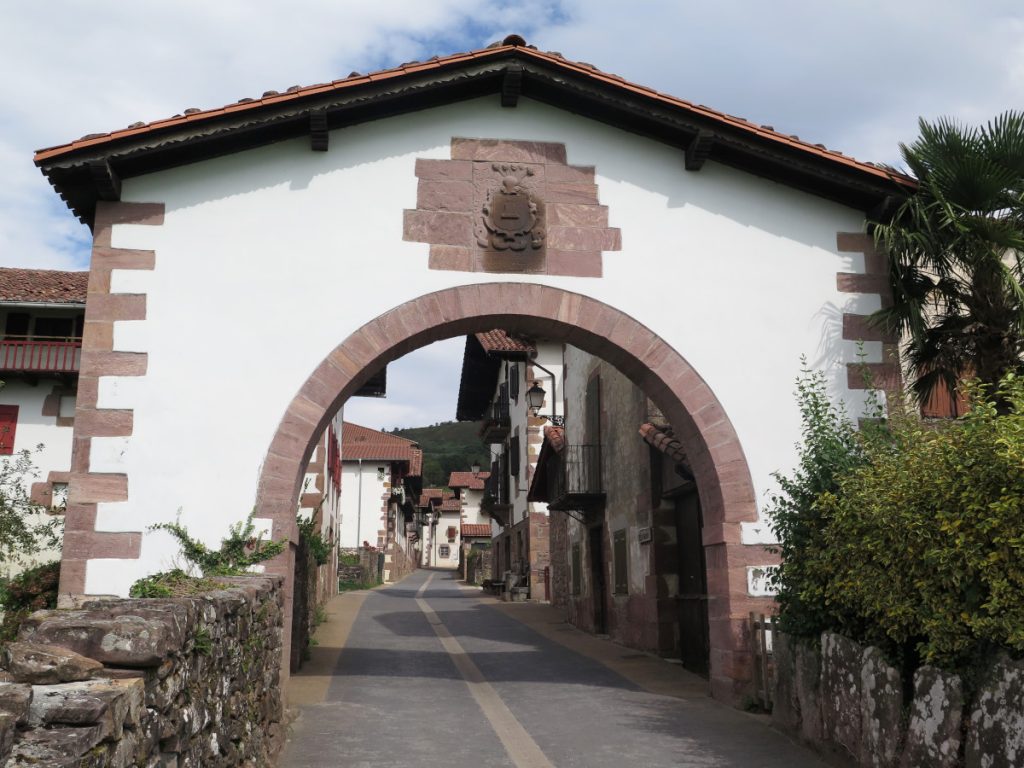
At Amaiur the last battle for the independence of Navarre was fought, it was the last bastion. After the battle of Noáin, the Navarrese loyal to the king took refuge on the other side of the Pyrenees. As a last stand in the attempted reconquest of the kingdom made an incursion into the Baztan-Bidasoa valley and conquered the castle of Amaiur and stayed there. In 1522 the Castilian troops reached the place and surrounded it with 10,000 men, against the 200 Navarrese garrison of the castle. The current monolith that we see on the site commemorates "To the men who fought for the independence of Navarre in the Castle of Maya".as it says at the bottom. The traces of the past emerge today thanks to the archaeological work carried out for 15 years by the Aranzadi Science Society and displayed in the recently inaugurated - August 2020 - archaeological centre on the main street of the village.
Another legacy of this medieval past is the General Assembly of the Baztan Valley of medieval origin which manages the extensive commons. City Council of 15 charming villages and dozens of hamletsThe most extensive municipality in Navarre. The villages of Baztan are colourful and stately, with large gabled houses, reddish stones, strong eaves and large balconies.
Elizondo and the "Baztan Trilogy".
After Irurita, Gartzain and Lecároz, to the right and left of the road, we reach the capital of the valley, ElizondoAn obligatory stop in the Baztan valley. Commercial and administrative centre. Mansions, palaces and monumental and religious buildings, the urban centre stretches along both sides of the river Baztan.. In the main street, the stately and palatial houses remind us of the prosperous past, which belonged to neighbours who emigrated to America. The palace of the Count or of the Gobernadoras, also known as the palace of the baroque palace of Arizkunenea -today's Casa de Cultura, or the porticoed building of the City Council.
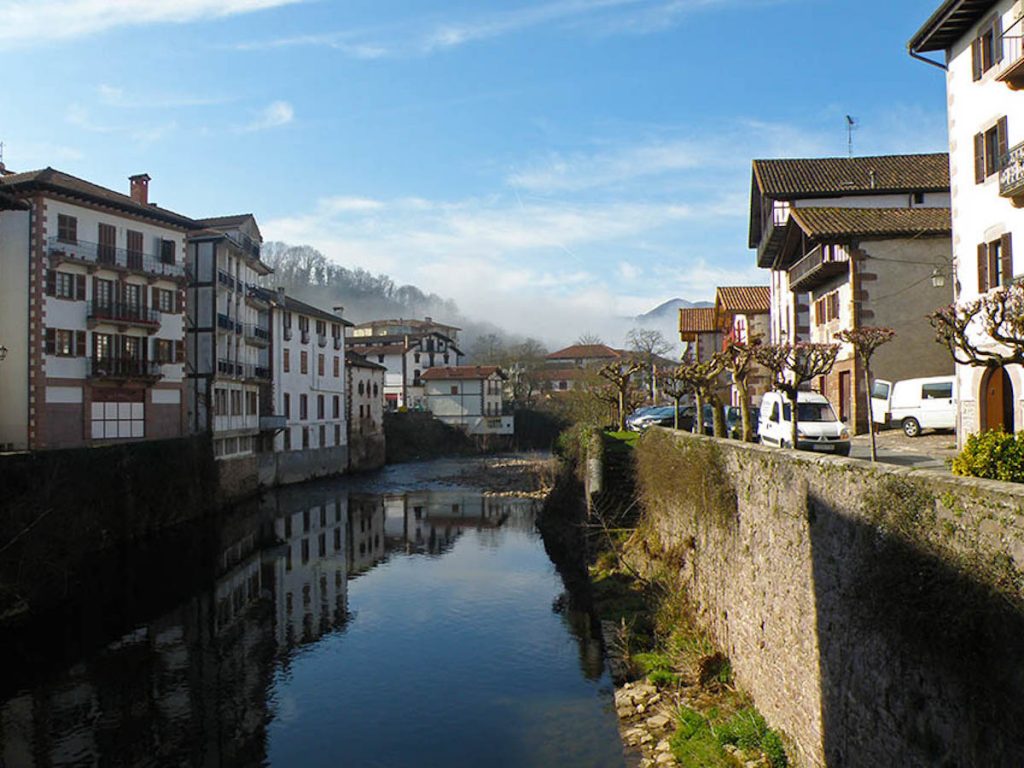
If the mists of the valley already lent an aura of mystery to the place and its forests, with the "Baztan Trilogy" written by Dolores Redondo and brought to the screen, visitors come to Elizondo in search of magical forests. The Invisible Guardian, The Legacy in the Bone and the final installment of the Trilogy, Offering to the stormlead us to a rainy valley of great oak and beech trees, legends, solitary hamlets, ancestral caves, and a village, Elizondo, where the walls of the houses and the streets tell stories. -and hide others-. Walking through the narrow streets of Elizondo hand in hand with inspector Amaia Salazar, stopping in front of the stone arch of Aunt Engrasi's house -today a tourist apartment-, having a drink on the terrace of Bar Txocoto next to the river, crossing the bridge that the inspector crossed so many times, go in search of Txantxigorri cakes at the Chocolatería Malkorra Gozotegia or the Mantecadas Salazar bakery -Panificadora Baztanesa-, visit the church, get lost in the cemetery looking for an angel on a tomb -which in the films seemed to have observed everything-. The Infernuko Errota - Road to Hell - runs around Elizondo, bordering the river, between the neighbourhood of Orabidea - Lekaroz - and Tximista. A small path reaches the Infernuko ErrotaThe Mill, which appears like a ghost in the harshness of a scenario from which Basajaun himself - a character from Basque mythology, the lord of the forests - could emerge. The building is a key element in "The North Face of the Heart", the prequel to the "Trilogy", and the journey takes us into magical corners which undoubtedly created the
Borderland
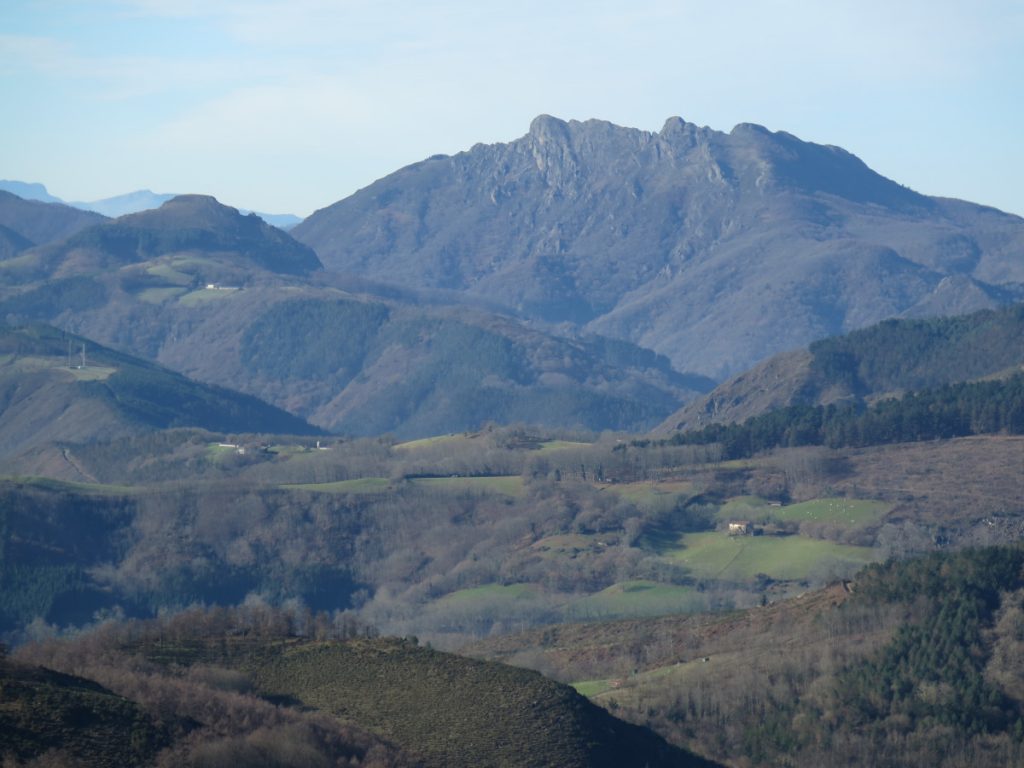
The port of Otsondo leads us to the head of the Baztan valley, the Xareta regionThe border land, with the villages of Urdazubi/Urdax and Zugarramurdi -together with the villages of Sara and Ainhoa in Lapurdi-, border land. The muga does not follow the logic of the Pyrenees mountains. Villages on the border, farms and forests that know nothing of it, caves and nooks and crannies, hiding places. Smuggling was the norm in these villages. Tobacco, alcohol and fuel were smuggled from village to village.on mats. A region without borders, 4 villages, family relations between them, was the perfect breeding ground for a network of relations and secondary roads without taking border posts into account. Packages of 25 kilograms passed from village to village, from house to house, on their backs on paths that linked hideouts, avoiding the high tariffs on these products that Franco recorded. In the mid-20th century it was a landmark area for the passage of goods and people. The most unsuspected things travelled from France to Spain, such as liquor, copper or penicillin. There were also those in the opposite direction, such as people during the Civil War or Portuguese emigration. Today, these paths and mountain passes are part of a hiking route, the Smugglers' Trailwhich in 7 stages recalls this "tradition" of the place. In the Dantxarinea border crossing pointToday, the old exchanges of goods take place in the new large shopping centres that have replaced the old sales and which receive customers from the French Basque Country and the Landes area on a daily basis. "During the months when the borders were closed due to the coronavirus - March - they say that in one of the ventas, families from one side and the other would meet up again by going out the back door to the border", Mikel Albisu tells us with a smile on his face. Clandestine activities from times gone by. Other witnesses of the border are the bunkers of line P - Defensive organisation of the Pyrenees built in the 1940s to prevent the Allies from entering Spanish territory, and which are still scattered around the area. Some of them are spectacular and very well preserved, such as the one on the peak of the AlkurruntzThe tunnel, above the Otsondo pass, runs 110 m underground through the mountain to open a machine-gun nest in a small window to strategic positions.
Akelarres and underground worlds
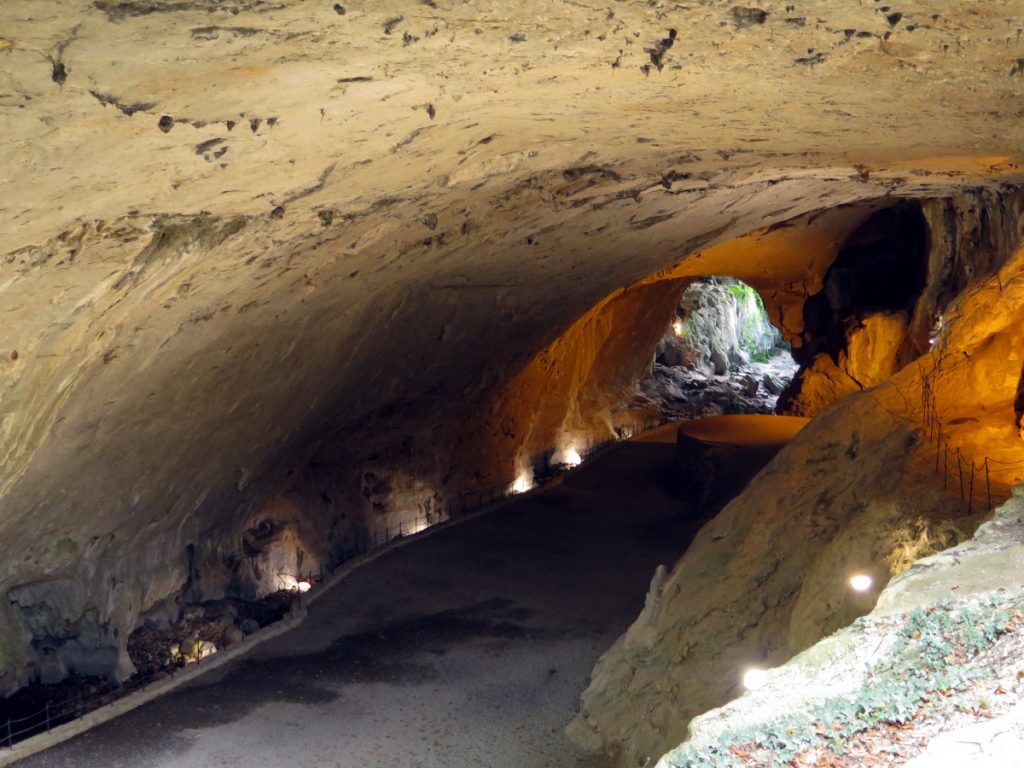
In the Sorginen Leizea cave -of the witches- of Zugarramurdi the river Olabidea or Infernuko erreka is entering the bowels of hell. The general, large cave is about 120 m deep, 30 m wide and 12 m high, an open cave, crossed by the creekThe cave has no stalactites and stalagmites, where we can find the remains of an old lime kiln. This is completed by two higher galleries, one of which is the cave of the akelarreThe cave is a smaller one, where the real and the imaginary, the legends and the facts of dark times, of fears, surrounded by conflicts and wars, in which any memory and previous pagan knowledge was persecuted. Next to the cave is the Berroscoberro meadowwhere the rituals of pacts with the devil, the akelarres; diabolical ceremonies, orgies by moonlight, around the bonfire. The reality is that in 1610, the famous Auto de Fe of the witches of Zugarramurdi concludes in Logroño. with 18 people reconciled, who confessed and appealed to the mercy of the court, and 6 who resisted were burned alive, as well as 5 in effigy - already dead - who did not survive the torture. Pure application of the Malleus maleficarumin the heat of the bonfire. Whether they were witches or healers who applied traditional knowledge, there was an important "witch-hunt" that spread throughout the area, in Bera the accusations multiplied and also in the rest of Cinco Villas. Superstition, envy, revenge and fantasy combined to create a witch-hunting fever. The Inquisitor Salazar visited the valleys for 8 months to gather information and first-hand testimonies, but found no conclusive proof. Today we do find a charming village, the village of Zugarramurdi, which has a Witch Museumlocated in a former hospital, which offers a different vision of witchcraft and what happened in the 16th century. Nearby is the village of Urdazubi/Urdax, with an ancient monastery of San Salvador and a mill.but what are well worth a visit are the Ikaburu caves. A guided tour takes us into an underground world, where we can contemplate beautiful limestone formations, stalactites and stalagmites, while we listen to the Urtxuma stream that flows through the cave. Both caves, Zugarramurdi and Ikaburu - in Urdax - are linked by a beautiful path, the blue Pottoka.
The Bidasoa and Malerreka regatta
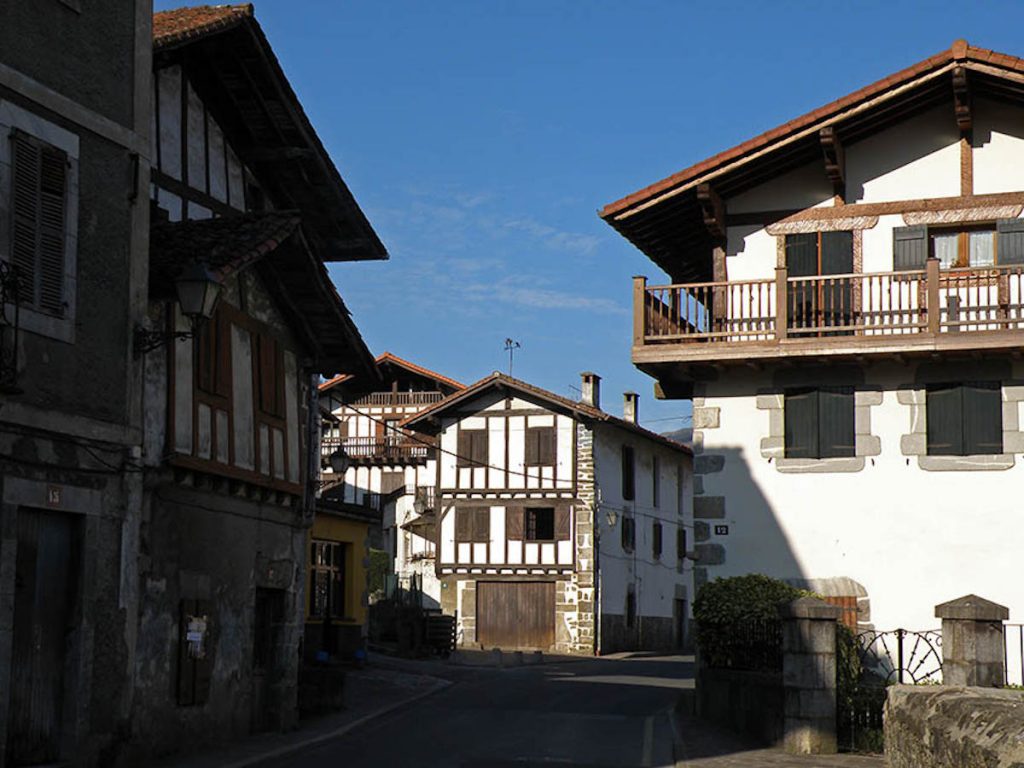
The winding mountain road reaches Etxalar. A small village in which since the Middle Ages there has persisted a old system of pigeon hunting with nets. The pigeon lofts of Etxalar have been declared a site of cultural interest. The reddish funerary stelae in the landscaped cemetery are worth a visit, reminiscent of the surnames of the houses in the village. We cross the Bidasoa to reach LesakaWe will walk through its streets with houses in which stone and wood go hand in hand, together with the white backgrounds, to create a very beautiful architecture. We will walk in search of the canal through which the river Onin, a tributary of the Bidasoa, flows, and where the dantzaris test their balance by dancing the Zubigainekoa on petriles in the Sanfermines of LesakaIt is said that it is in memory of the peace signed between the districts of Legarrea and Pikuzelaia in the 15th century. The whole is rounded off by stately homes and two beautiful medieval towers, Minyurinea and Zabaleta.which stands in the middle of the town. The development of the town with the steel industry -Laminaciones de Lesaca, SA. - in the 50s and 60s contrasts with the beauty of the old town. The neighbouring town of Berathe last of the Cinco Villas, where you can walk through the neighbourhood of Altzate, with its beautiful farmhouses, and where you can find the Baroja House -Just above Bera stands the Mount LarunThere are two border crossings: the one at the Lizuniaga pass and the one at Ibardin, with sales at both, but what is most surprising is the one located at the top of Larun, the border itself, which can be reached by a rack railway from the French side and which has unbeatable views over the bay of Txingudi. But the journey would not be complete if we did not go up to the head of the race. At Igantzi is located in the Reserve of San Juan de XarThe park is located in a natural setting with hornbeams, ash, oak, lime and hazel trees, and the hermitage of San Juan Bautista nestled in the interior of this natural spot. But if you're looking for adrenaline, at the rural resort and adventure park at Irrisarri Land a zip-line system or a zip-line circuit. bike park The beach is a delightful place to relax in one of its luxurious bays. At Malerreka -valle of Santesteban and Basaburua menor- water springs in rivers and streams; also salty water like that of the Elgorriaga Spa ResortIt has the most saline medicinal water spring in Europe. In the nearby Zubieta a channel diverts the river's flow to an old mill now converted into an eco-museum. Built in the 18th century, it was a royal mill until the disentailment of Mendizábal in the mid-19th century. In the last week of January, Zubieta and the neighbouring town of Ituren join together in the celebration of the carnivalsone of the most curious in Navarre; the zanpantzar of the joaldunak and the motley retinue in which costumes of mysterious nature meet rural frenzy. Doneztebe/SantestebanThe old capital maintains the air of a mountain village with magnificent mansions from the 17th and 18th centuries on both sides of its main street. Most of the villages on the banks of the Bidasoa are linked by a 27-km greenway that takes advantage of the route of the old Bidasoa railway -the Txikito train-. Nearby are the Leurza reservoirsThe route takes us to the village of Donamaria, with its recreational area, in the middle of magnificent beech forests, which can be reached via the road to the village of Urrotz. On the way back along the road, we can enjoy the beautiful valley where Donamaria and its neighbourhoods are located, a beautiful sight to say goodbye to the high valleys of the Bidasoa.
Flavours of Baztan-Bidasoa
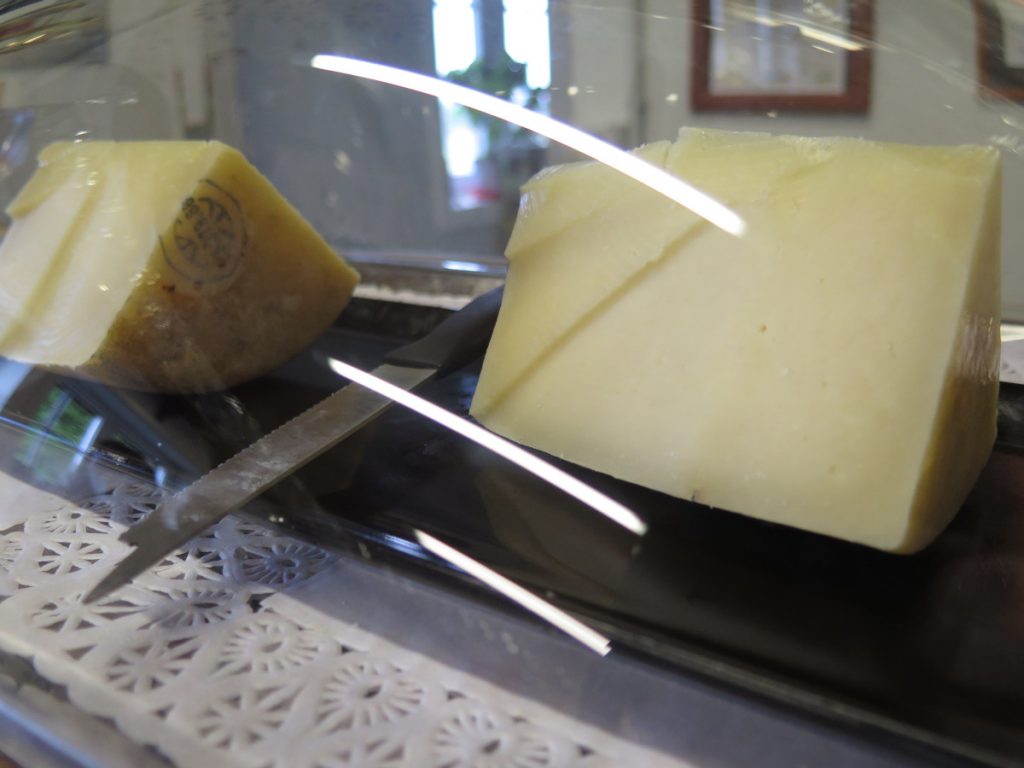
"And my brother and I decided to go back to the family business, me more dedicated to making cheese and him to looking after the sheep". Our stop halfway along the blue pottoka trail, on the way from Zugarramurdi to Urdax, is inspiring. The cheese producer, Ana Mari, tells us how her parents made cheese as a family and took the step to set up a cheese factory in the lower part of the house. They made and sold cheese for 20 years, but the business was not going to continue until they decided to quit their jobs and return to the family tradition. Ana Mari, who has a degree in Lade, left her job at the bank to make a carefully crafted cheese, the one from the Etxelekua farmhouseThe cheese, Idiazabal, is an authentic Latxa sheep's cheese that has won several prestigious international prizes. Dairy production is deeply rooted in these valleys. latxa sheep's cheese or cuajada (curd cheese). They accompany a gastronomy linked to the extensive meadows where livestock graze and to a vegetable garden that provides leeks, beans, pods, lettuce, tomatoes, peppers and potatoes. "Txuri ta beltz". is a typical dish, sangrecilla con relleno, a kind of black pudding typical of Navarre. As well as grilled lamb, veal chop, beef steak, the "Baztan-zopa"The local cuisine includes a soup of sheep's butter, salmon from the Bidasoa, trout and duck products. In autumn, the Baztan celebrates the gastronomic days of hunting, in which you can not miss the wood pigeon. Accompanying mushrooms and fungi provided by forests. Special mention should be made of the talos made with maize flour from the valley's mills, such as Etxaide, Zubieta and Amaiur. And finally, Urrakin egina chocolate and pastries from Elizondo, piperropiles or pepper cakes and canutillos from Sunbilla.
YOU MAY BE INTERESTED IN: Baztan with children
Baztan-Bidasoa, the eternally green valley / Cover photo: Eduardo Azcona
Fastpacking is not about going faster. It's about going lighter.
If you come from classic trekking, this is the next step: learning to move with less weight,
more fluid and enjoying every kilometre more.
Join the channel and start discovering what lightness feels like.
